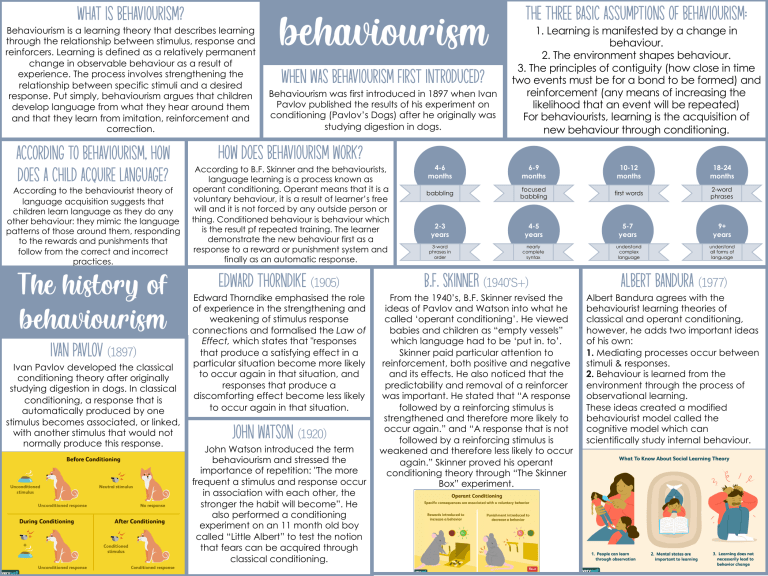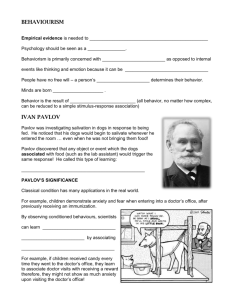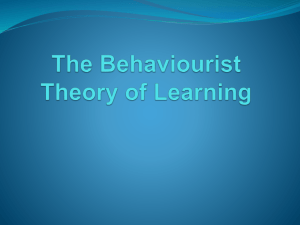
What is behaviourism? Behaviourism is a learning theory that describes learning through the relationship between stimulus, response and reinforcers. Learning is defined as a relatively permanent change in observable behaviour as a result of experience. The process involves strengthening the relationship between specific stimuli and a desired response. Put simply, behaviourism argues that children develop language from what they hear around them and that they learn from imitation, reinforcement and correction. According to behaviourism, how does a child acquire language? According to the behaviourist theory of language acquisition suggests that children learn language as they do any other behaviour: they mimic the language patterns of those around them, responding to the rewards and punishments that follow from the correct and incorrect practices. The history of behaviourism Ivan pavlov (1897) Ivan Pavlov developed the classical conditioning theory after originally studying digestion in dogs. In classical conditioning, a response that is automatically produced by one stimulus becomes associated, or linked, with another stimulus that would not normally produce this response. behaviourism When was behaviourism first introduced? Behaviourism was first introduced in 1897 when Ivan Pavlov published the results of his experiment on conditioning (Pavlov’s Dogs) after he originally was studying digestion in dogs. The three basic assumptions of behaviourism: 1. Learning is manifested by a change in behaviour. 2. The environment shapes behaviour. 3. The principles of contiguity (how close in time two events must be for a bond to be formed) and reinforcement (any means of increasing the likelihood that an event will be repeated) For behaviourists, learning is the acquisition of new behaviour through conditioning. How does behaviourism work? According to B.F. Skinner and the behaviourists, language learning is a process known as operant conditioning. Operant means that it is a voluntary behaviour, it is a result of learner’s free will and it is not forced by any outside person or thing. Conditioned behaviour is behaviour which is the result pf repeated training. The learner demonstrate the new behaviour first as a response to a reward or punishment system and finally as an automatic response. 4-6 months 6-9 months 10-12 months 18-24 months babbling focused babbling first words 2-word phrases 2-3 years 4-5 years 5-7 years 9+ years 3-word phrases in order nearly complete syntax understand complex language understand all forms of language Edward thorndike (1905) B.F. SKINNER (1940ʼS+) albert bandura (1977) Edward Thorndike emphasised the role of experience in the strengthening and weakening of stimulus response connections and formalised the Law of Effect, which states that "responses that produce a satisfying effect in a particular situation become more likely to occur again in that situation, and responses that produce a discomforting effect become less likely to occur again in that situation. From the 1940’s, B.F. Skinner revised the ideas of Pavlov and Watson into what he called ‘operant conditioning’. He viewed babies and children as “empty vessels” which language had to be ‘put in. to’. Skinner paid particular attention to reinforcement, both positive and negative and its effects. He also noticed that the predictability and removal of a reinforcer was important. He stated that “A response followed by a reinforcing stimulus is strengthened and therefore more likely to occur again.” and “A response that is not followed by a reinforcing stimulus is weakened and therefore less likely to occur again.” Skinner proved his operant conditioning theory through “The Skinner Box” experiment. Albert Bandura agrees with the behaviourist learning theories of classical and operant conditioning, however, he adds two important ideas of his own: 1. Mediating processes occur between stimuli & responses. 2. Behaviour is learned from the environment through the process of observational learning. These ideas created a modified behaviourist model called the cognitive model which can scientifically study internal behaviour. John watson (1920) John Watson introduced the term behaviourism and stressed the importance of repetition: "The more frequent a stimulus and response occur in association with each other, the stronger the habit will become”. He also performed a conditioning experiment on an 11 month old boy called “Little Albert” to test the notion that fears can be acquired through classical conditioning. DOES THE BEHAVIOURISM THEORY SUPPORT NATURE VS NURTURE LEARNING? Yes. Behaviourists fall squarely on the nurture side of the nature vs nurture debate. According to “radical behaviourists” like John Watson, what determines the intelligence, temperament and other personality characteristics of a child, is the environment in which the child is raised. Genetic predisposition is unimportant. One of Watson’s most famous quotes is “Give me a dozen healthy infants, well-formed, and my own specified world to bring them up in and I’ll guarantee to take any one at random and train him to become any type of specialist I might select - doctor, lawyer, artist, merchant-chief, and, yes, beggar-man and thief, regardless of his talents, penchants, tendencies, abilities, vocations, and race of his ancestors.” child language acquisition theories Innatism (Chomsky) Noam Chomsky theorised that the mechanism of language acquisition is derived from the innate process. Innate is something which is already there in mind since birth. The theory proposed by Chomsky is proven by the children living in the same linguistic community. Behaviourism (b.f. skinner) B.F Skinner’s theory was based on his beliefs of how behaviour and actions could be controlled by their consequences. He believed that positive reinforcement was successful within children’s education as it encouraged them to try their best and complete work to their best potential. Interactionism (vygotsky) Lev Vygotsky’s theory of language development focused on social learning and the zone of proximal development (ZPD). The ZPD is a level of development obtained when children engage in social interactions with others; it is the distance between a child’s potential to learn and the actual learning that takes place. reference list https://prezi.com/tqcwnimurhih/behaviourism/ https://www.simplypsychology.org/behaviorism.html https://www.verywellmind.com/behavioral-psychology-4157183 https://blogs.glowscotland.org.uk/glowblogs/uodedueportfoliosm/2015/11/05/language-acquisitionskinner-and-chomsky/ https://www.khanacademy.org/test-prep/mcat/processing-the-environment/language/v/theories-oflanguage-development http://web.mst.edu/~rhall/ed_psych/behaviorism.html https://medium.com/@llanirfreelance/first-language-acquisition-development-theories-nature-vsnurture-27170818a6a6 https://sites.google.com/site/ide621knowledgebaseriley/behaviorism/behaviorism-infographic-1 http://www2.vobs.at/ludescher/Ludescher/LAcquisition/Behaviourist/seite11.htm https://www.myenglishpages.com/blog/behaviorism/ https://www.slideshare.net/satyapermadi/behaviorism-48084225 https://msu.edu/~yorkrobe/Webb/Final/lt_behaviorism.htm http://changingminds.org/explanations/behaviors/conditioning/history_behaviorism.htm https://www.verywellmind.com/operant-conditioning-a2-2794863 https://www.simplypsychology.org/bandura.html https://www.simplypsychology.org/behaviorism.html https://www.enotes.com/homework-help/how-is-language-learned-according-to-the-144887 https://www.docsity.com/en/behaviorist-theory-of-language-acquisition/5200479/ https://courses.lumenlearning.com/atd-hostos-childdevelopment/chapter/human-languagedevelopment/






